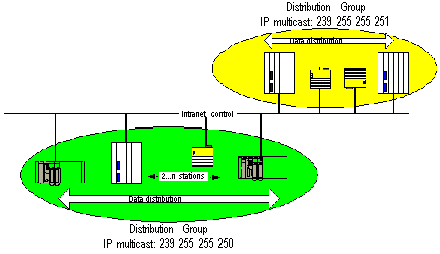The aim of Global Data, which is supported by the TSX ETY 4103/PORT/5103 modules and the Ethernet link of the TSX P57 6634/5634/4634, is to provide an automatic data exchange for the coordination of PLC applications.
The communication modules are regrouped in a Distribution Group to exchange the variables used for PLC coordination.
Each communication module publishes a local application variable for the other communication modules in the Distribution Group.
Each communication module can also subscribe to the application variables published by all other modules sharing the Distribution Group, whatever its location.
An Application Variable is a group of contiguous words from a PLC.
Through Global Data configuration you can define:
Once the module is configured, exchanges between the communication modules sharing the same Distribution Group are automatically carried out when the PLC is in RUN mode.
A Distribution Group is a group of communication modules identified by the same multicast IP address. Exchanges in "multicasting" are used to distribute Global Data. Several independent Distribution Groups can co-exist on the same subnetwork with their own multicast address.
A publication/subscription protocol on UDP/IP is used for data distribution.
The publication of a variable is synchronized at the start of the PLC cycle.
Subscribed variables are copied in the PLC application memory at the end of the cycle.
The PLC memory zones that receive the various subscribed variables should not be recovered.
A Health bit (status bit) is associated to each application variable.
This status bit indicates the validity of each subscribed variable: it is 1 if the variable has been published and received in the
configured validity time limit, otherwise it is 0.
The global data service synchronizes several stations located in a distribution group. A distribution group is a set of stations identified by using the same IP multicast address for all stations in the group. By using the same IP address for multiple devices, multicast exchanges can be used to distribute global data. Several independent distribution groups can coexist on the same sub-network. Each distribution group possesses its own unique IP multicast address.
Early versions of switches treat multicast packets as a broadcast, thereby broadcasting to all nodes and suppressing all benefits of both switching and multicasting. Newer versions of switches provide automatic multicast filtering, and consequently only forward multicast traffic to ports that are connected to registered end stations.
The following multicast filtering protocols are supported by Ethernet modules for its global data service.
-
GARP Multicast Registration Protocol (GMRP)
GMRP provides a mechanism that allows bridges and end stations to dynamically manage the membership of multicast groups.
NOTE: GMRP is defined in the IEEE 802.1D-1998 Standard, which is available as a free download at: http://IEEE802.org.
-
Internet Group Management Protocol (IGMP)
IGMP is a communications protocol used to manage the membership of internet protocol multicast groups. IGMP is used by IP hosts and adjacent multicast routers to establish multicast group memberships.
The operating modes are as follows:
-
Stopping the PLC stops Global Data exchanges.
-
The use of the I/O forcing system bits (%S9,%SW8,%SW9) does not stop Global Data exchanges.
There are no theoretical limits for the number of stations sharing a Distribution Group. The main limitation is the number of variables exchanged in the Distribution Group (64 variables).
